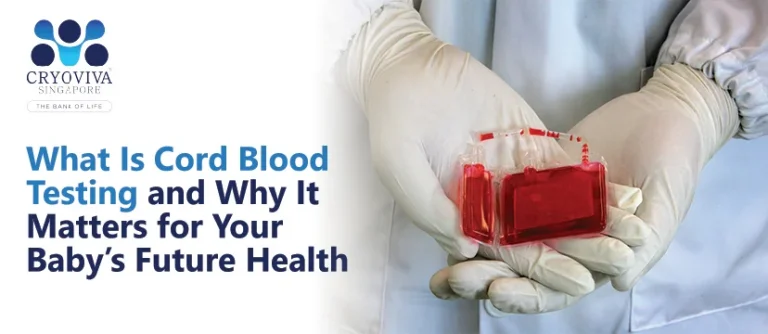Blog
What Is Cord Blood Testing and Why It Matters for Your Baby’s Future Health

Dear parent, you made the ultimate big decision: “storing your baby’s cord blood for stem cell preservation.” Kudos to you from Cryoviva Singapore for joining the many parents in Singapore who’ve decided to take this step to secure their babies’ and their families’ future health. Like many, now, the major worry is off your shoulders, and you can concentrate on all the little joys of your baby’s arrival.
But before the cord blood (leftover blood in your baby’s umbilical cord and placenta right following birth) is stored for the future, there’s one crucial step, i.e., cord blood testing. Think of this test as a quick safety check before stem cell preservation. It ensures the cord blood is healthy, safe, disease-free, and ready for use in the future, if ever required. It’s similar to giving your baby’s first health report card: simple, reassuring, and essential. With this done, you can breathe easier knowing you’ve taken care of tomorrow today.
What is Cord Blood Testing?
Cord blood testing is a simple test procedure. It is done on the blood collected from a baby’s umbilical cord immediately after birth. It evaluates crucial health markers such as blood type, bilirubin level, infections, blood count, and oxygen levels. These help your doctors in Singapore understand the newborn’s health clearly; then they make the final decision if or not cord blood is healthy, safe, and disease-free for future use if ever required.
What is the Test Procedure?
The cord blood test for newborns follows this simple procedure:
- Immediately after the delivery, the umbilical cord is clamped and cut.
- A technician from Cryoviva Singapore uses a sterile needle to collect blood from the umbilical vein in the cord.
- Then the blood is transferred into a special blood bag.
- The blood collection requires only a few minutes. And do not worry; it is a painless and safe procedure for mother and baby.
- The collected cord blood is sealed, carefully labeled, and stored in a temperature-controlled transport kit.
- Within 48 hours, the sample is then sent to a licensed laboratory for processing.
- Then the blood is checked for various parameters like blood volume and cell counts.
- Centrifugation is done to separate stem cells and blood components. This helps concentrate useful cells only.
- The cord blood unit is cryofrozen and stored at -196° in the vapor phase of liquid nitrogen. It is stored in specially designed steel tanks for long-term storage.
- Parents are given the clear test report.
- Parents in Singapore also receive a storage certification if banking is done.
Note: The whole process is done with strict quality and safety standards enforced by Singapore’s Ministry of Health and international guidelines.
What Does Cord Blood Testing Check For | Key Parameters
The following parameters are checked before storing cord blood for stem cell preservation:
Gases in Newborn’s Blood
This parameter measures oxygen and acid-base (pH) balance. It shows if the baby is getting enough oxygen or not.
How may it help?
Spot issues such as trouble breathing or asphyxia (deficient supply of oxygen to the body) at birth.
Levels of Bilirubin
It checks the levels of bilirubin (a waste product made by the liver) in the cord blood.
How may it help?
Detect jaundice, which causes yellow skin and eyes. Early detection prevents complications like brain damage and other risks if bilirubin levels are too high.
Blood Culture Test
Detects the presence of any infections, including bacteria in the blood.
How may it help?
This helps doctors to take early action to treat newborn infections immediately before storing the blood.
Complete Blood Count (CBC)
Examines the levels of important blood components like red and white blood cells and platelets.
How may it help?
It helps identify anemia, infections, clotting problems, or immune system-related issues.
Blood Glucose (Sugar) Levels
Evaluate sugar levels, especially if the mother has a history of diabetes.
How may it help?
Low or high levels may indicate metabolic problems. This also helps guide feeding and personalized care plans.
Exposure to Illegal or Certain Prescription Drugs
Inspect the traces of illegal drugs, sedatives, or certain prescribed medications in the baby’s cord blood.
How may it help?
It helps the doctor in the faster decision-making process to decrease risks for growth and developmental delays or other health issues.
Cord Blood Testing for Genetic Conditions
After approval from the parents, cord blood is also checked for genetic disorders. This is done by analyzing DNA for abnormal mutations or gene changes.
How may it help?
It helps identify treatable rare diseases and provides support for genetic counseling. Additionally, it encourages timely management to enhance overall health.
Conclusion
Cord blood testing can be an important step that parents in Singapore can consider, whether they choose to store cord blood or not. It is one of the best ways to carefully check a baby’s blood health for early detection of health issues. This ensures the preservation of the quality of stored stem cells for potential future therapy.
FAQ's
Absolutely. Cord blood collection is possible in both vaginal and C-section deliveries in Singapore hospitals.
Most public and private hospitals in Singapore support cord blood collection. It’s recommended to inform your hospital and doctor in advance and coordinate with your chosen cord blood bank.
Absolutely. Cord blood collection is possible in both vaginal and C-section deliveries in Singapore hospitals.
Yes. Cord blood collection, processing, and storage are regulated by Singapore’s Ministry of Health (MOH) to ensure safety, quality, and ethical practices. Licensed cord blood banks must follow strict guidelines.


